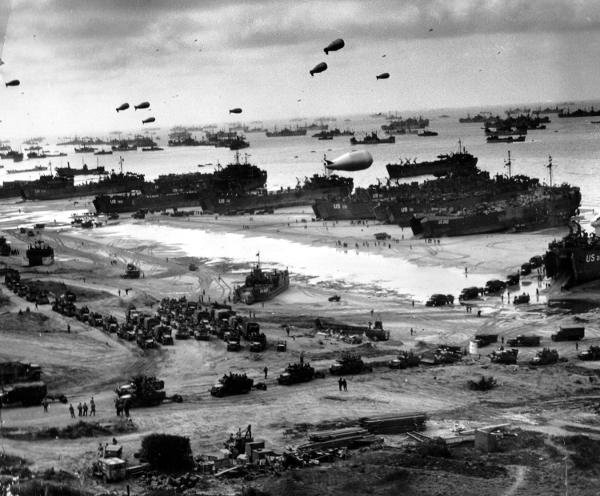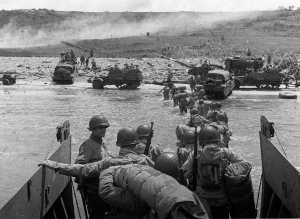The landings
Not all of the paratroopers reached their targets. Some overshot; some were killed. Laden with equipment, those who landed in the marshlands that German Field Marshal Erwin Rommel had ordered flooded struggled to stay above water. Many drowned; others were shot. Some paratroopers never landed alive, shot out of the sky. One well-known situation involved a paratrooper whose parachute became entangled in a church steeple; he hung there for two hours before he was captured. Batteries on the coast began firing at the Allied forces at 5:30 a.m. Providing the Allied response, just before 6 a.m., were 1,000 British planes dropping 5,000 tons of bombs on the German gun batteries. Allied ships got into the act as well, shelling for a few hours beforehand. The first land forces left their landing craft at 6:31. Because of the rough seas, many landing craft had to stop well short of their targets, leaving men to fend for themselves by walking to shore amidst a withering barrage of gunfire. 
On the day, about 156,000 troops landed on the beaches at Normandy. Nearly half of those were from the U.S. Troops from the U.K. numbered more than 60,000, and Canadian troops numbered more than 20,000. Troops from these other countries also participated in the invasion: Australia, Belgium, Czechoslovakia, Denmark, France, Greece, the Netherlands, New Zealand, Norway, and Poland. 
The landings took place at five beaches: Gold, Juno, Omaha, Sword, and Utah. American forces landed at Omaha and Utah beaches, and British and Canadian troops landed at Gold, Juno, and Sword beaches. Together, the five beaches stretched for 50 miles. The experience of the American landing parties was markedly different. Resistance at the westernmost beach, Utah, was light because the Allied bombardment had achieved most of its objectives. The remaining German defenders on Utah beach provided little resistance, and the Allied forces cleared the area within three hours, with 23,000 men and 28 tanks landing onshore. Allied casualties were fewer than 200. At the fiercely contested Omaha beach, only two of the 29 amphibious tanks made it on land without assistance. Allied bombing runs had not affected this beach as much as the other ones, and the fighting was intense. As well, this beach had high cliffs on top of which many gunmen were hidden or otherwise unaffected by the aerial and naval bombardments. The Allied high command at one point considered abandoning Omaha beach and pulling the troops back. The Allies slowly turned the tide. A pair of battalions of U.S. Rangers scaled the cliffs, which were 100 feet high, at Point du Hoc and, after losing 60 percent of their attack force, silenced a group of six German howitzers. Allied soldiers had secured Omaha beach by nightfall, putting 34,000 men ashore. They had lost about 2,000. Landing at the other three beaches were forces under the command of the British Second Army. They landed at 7:30 a.m. in order to take advantage of a tidal shift in the area. Troops at Gold beach got onshore, overcame some pockets of stiff resistance, and had established a position by nightfall. Punctuating their progress were groups of armored vehicles known as "Funnies," clearing minefields as they went. The Gold beach troops had not, however, linked up with the force that landed on Omaha beach, which had been one of the goals. Choppy seas caused a delay in the attack by Canadian troops at Juno Beach. Fighting was fierce, and they lost 50 percent of their numbers in the early going but pushed ahead, overcoming resistance. They achieved their goal of linking up with British forces on Gold beach. The British troops attacking Sword beach met stiff resistance as well. After an initial setback, they pushed forward, turned back a German counterattack (destroying half a division of panzers in the process), and linked up with the 6th Airborne Division. "Funnies" helped on this beach as well. Casualties numbered about 650. At the end of the day, Allied commanders considered the mission a success. They had established a beachhead on all five beaches and were in good position to continue eastward through central France and also west, to the vital port of Cherbourg, and northeast, to the equally vital port of Caen. Next page > And in the End > Page 1, 2, 3, 4, 5 |
|
Social Studies for Kids
copyright 2002–2025
David White




